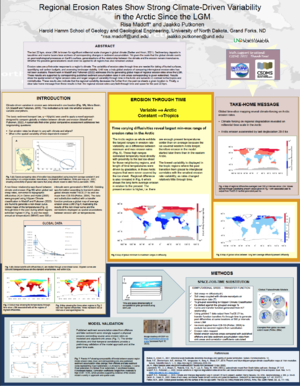2022 CSDMS meeting-054
(if you haven't already)
Log in (or create account for non-CSDMS members)
Forgot username? Search or email:CSDMSweb@colorado.edu
Browse abstracts
Regional Erosion Rates Show Strong Climate-Driven Variability in the Arctic Since the LGM
Erosion rates are a first-order response to climate of a region. The variability of erosion rates through time are needed for dating of buried surfaces, quantifying soil carbon budgets, and assessing landscape stability. Until now, a truly global analysis of comparing interregional erosion rates has not been available. Recent work in Madoff and Putkonen (2022) addresses this by generating global maps of regional erosion rates since the LGM. These results are supported by corresponding published sediment accumulation rates in sink areas corresponding to given watershed. Results show the spatial extent of higher erosion rates and larger ranges of variability through time in the Arctic and subarctic in contrast to the tropics and mid-latitudes. These results also indicate that the regional variability decreases the further from the past ice sheets a given location is. Finally, a clear take home message from these results is that the regional erosion rates vary both through time and space for the past 22 ka.
- Barker, S., Knorr, G., 2021. Millennial scale feedbacks determine the shape and rapidity of glacial termination. Nature Communications. 12.
- Madoff, R.D., Putkonen, J., 2022. Global variations in regional degradation rates since the Last Glacial Maximum mapped through time and space. Quaternary Research. 1–13. https://doi.org/10.1017/qua.2022.4

